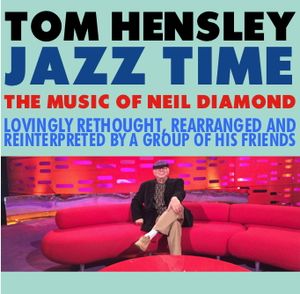On April 21, 2017, I released a little album with a long title. It was called “Jazz Time: The Music of Neil Diamond.”
I didn’t know at the time that it would be a wrapup to my 40-plus years of touring with Mr. Diamond, but it turned out to be perfect for that occasion.
The album chalked up some sales during the tour, since it was usually available at the merchandise stands in the venues we played.
 But unless you attended one of our shows, you might not have known about it, since there was little publicity other than a few radio interviews along the way.
But unless you attended one of our shows, you might not have known about it, since there was little publicity other than a few radio interviews along the way.
To tell the truth, I’m far removed from the jazz mainstream, whatever that is, although I once floated in it—but that was back in Indiana in the late 1960s, which leads me to the story of how Jazz Time came about.
I remember when Andre Previn, Shelley Manne and Leroy Vinnegar released a jazz trio album of the music from “My Fair Lady” to resounding success. I remember thinking that it was a neat trick to turn songs there were so non-jazzy into a totally cool and hip experience, and wondered if that might be possible with Neil’s melodies.
I thought it would be fun to pretend that I was putting together a compilation album of Diamond songs as they might have been treated if they had been on some of my favorite jazz albums. So…
The first one that became obvious to me was “Holly Holy.”s Placing it in the style of Ahmad Jamal’s classic recording of “Poinciana” came to me so naturally that it was a breeze to record.
I thought “Kentucky Woman” would be difficult, because it is such a major-chord tune, but when I reharmonized it. got our genius horn guys to flesh it out, and added some subtle Dean Parks steel guitar magic, and hoped to make it feel like an outtake from Miles Davis’s “Birth of the Cool” album.
One song that many fans haven’t heard as much was “Home is a Wounded Heart,” and I fashioned it after a beautiful album of ballads recorded long ago by Johnny Hartman and John Coltrane.
That one turned out so well that when we began rehearsing for our 2017 tour, we used that same approach for a new version of “You Don’t Bring Me Flowers,” in which Larry Klimas filled the Barbra Streisand/Linda Press duet role. He did it so well that on tour we were treated the spectacle of witnessing a tenor saxophone solo receiving a nightly standing ovation.
The version of “September Morn” on the album was inspired by a long-ago album featuring violinists Yehudi Menuhin and Stephane Grappelli. I first recorded the piano accompaniment and then asked Alicia Engley (from our beloved Catgut Grrlz) to play on top of it it. She loved the idea, but told me she didn’t really improvise. (She plays so beautifully and naturally that I always had assumed she was jamming with us.)
I remembered that Alan Lindgren was a violinist way back before he became a brilliant keyboardist and arranger, and so I persuaded him to write out a violin solo for Alicia, turning it almost into a little sonata, which she played so perfectly that I told her that when people hear it, she will be deluged with calls for jazz gigs.
That’s enough blabbing or now. There’s a story for every song on the album, and I hope some of you who don’t know about it will give the songs on Jazz Time a listen and comment about them and speculate on what you think inspired them..
Spoiler alert: I did “Hello Again” in the style of almost every pianist I’ve ever admired.
